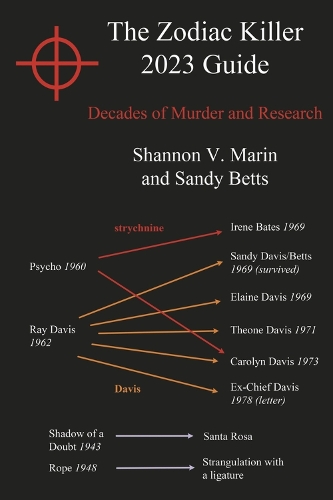
The Zodiac Killer 2023 Guide: Decades of Murder and Research
(Paperback)
Publishing Details
The Zodiac Killer 2023 Guide: Decades of Murder and Research
By (Author) Shannon V Marin
BookBaby
BookBaby
18th September 2023
United States
Classifications
General
Non Fiction
Physical Properties
Paperback
248
Width 152mm, Height 228mm, Spine 15mm
403g
Description
In his 1986 book, the author Robert Graysmith speculated that Zodiac continued to kill long after a near arrest in San Francisco in 1969, but this was a divisive idea. An alternate view, apparently popular in law enforcement, was that Zodiac's murders preceded or overlapped with those of an unrelated killer hunting girls and young women in the Greater San Francisco Bay Area. The Santa Rosa Hitchhiker Murders were a core part of this theory. In both sets of killings, females with blonde or light brown hair were the preferred targets. As information about both cases has grown and been refined, the number of common elements between the Zodiac killings and the Santa Rosa killings has grown. Though not the focus of this book, law enforcement apparently has entertained the idea that the perpetrator of the Santa Rosa murders killed in several other states. While such a scenario is still speculative, there are strong reasons to believe that Zodiac continued to kill, year after year, for decades.
The most elaborate Zodiac attack was at Lake Berryessa in September of 1969. Zodiac had made a costume and manipulated two young adult victims, claiming that he was carrying out a robbery to flee to Mexico. Once the victims were bound, Zodiac stabbed them. He probably left the male alive intentionally. While this is a confirmed Zodiac attack, its elaborate nature is often ignored. When considered with television and film themes in messages the killer sent, we have a theatrical, almost comic book murderer. This is important when evaluating unsolved claims of Zodiac responsibility.
This book focuses on the characteristics of the different crimes in which Zodiac is confirmed or suspected. Some unsolved homicides with Zodiac-like characteristics are included. Crimes for which Zodiac is no longer a suspect are provided as well. As the search for Zodiac victims has been centered on the general areas of San Francisco and Vallejo, the authors hope that this book will contribute to identifying overlooked victims in other regions.
Author Bio
During the Covid-19 pandemic, Shannon Marin began to delve into online material and books about the Zodiac case and similar killings. He was amazed by the large number of insights that existed and had mostly been discarded. Studying the case felt like looking at a table with a handful of pieces to a jigsaw puzzle and then finding that dozens and dozens of matching pieces were lying on the floor. Corresponding with Sandy Betts, Shannon explored a complex scenario in which the body count was probably well over 100. As the weeks and months went by, Shannon came to accept that the Zodiac killer was active at least into 1999. Shannon hopes that this book will motivate both professional investigators and amateur researchers to consider Zodiac as a valid suspect in many unsolved homicides.
In the 1960's, and especially 1969, Sandy Betts suffered bizarre harassment and attacks. Sandy worked in Vallejo, California, but did not at first associate the malicious acts with Zodiac. Unable to give the police useful information, she had to persevere through years of stalking and lethal danger. In 1990, Sandy began to study the Zodiac case seriously. She spent hour after hour researching confirmed and possible Zodiac attacks. Sandy connected with many people investigating and contributing analysis to Zodiac and related crimes. She has also been able to fit many of the pieces of her part of the Zodiac puzzle together. Her view of Zodiac, which she equates with the individuals who attacked and harassed her, is that they were evil and caused terrible suffering for the friends and families of many, many homicide victims.
Sandy Betts has provided the moral components of trying to stop attacks and give resolution for the people who have lost loved ones over the years.
